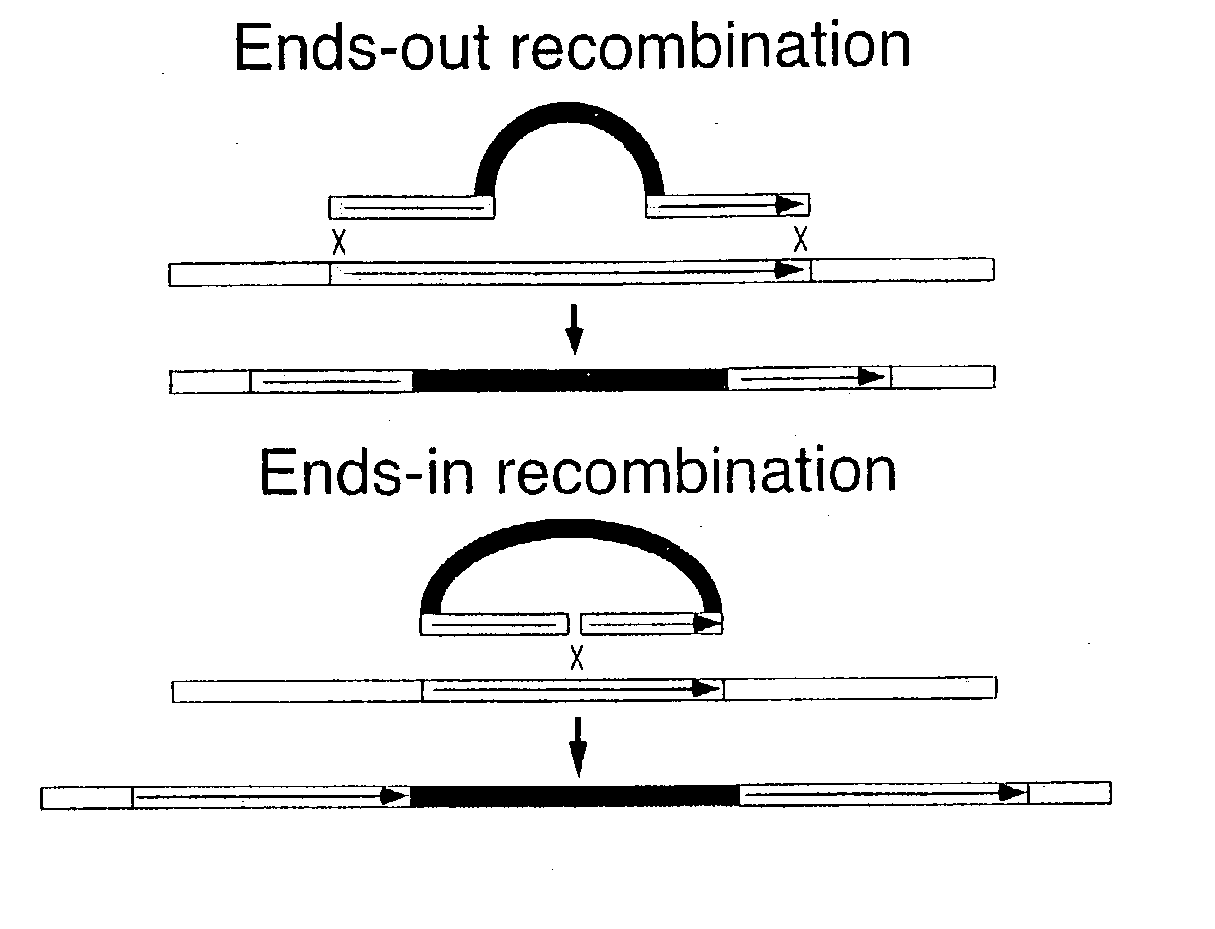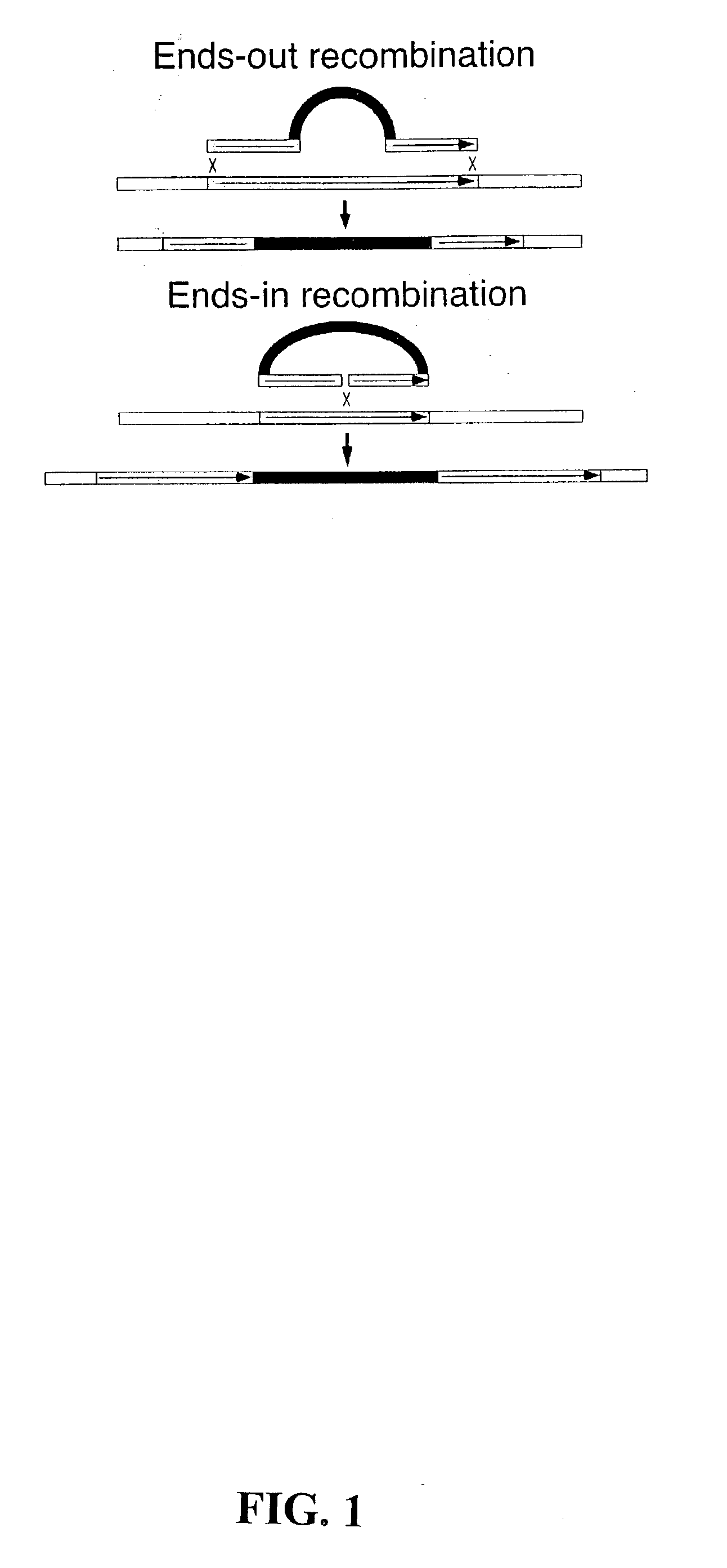Ends-out gene targeting method
a gene targeting and endsout technology, applied in the field of endsout gene targeting method, can solve the problems of low frequency, method is limited, and methods have not been applicable to a wider range of organisms
- Summary
- Abstract
- Description
- Claims
- Application Information
AI Technical Summary
Benefits of technology
Problems solved by technology
Method used
Image
Examples
example 1
[0105] An ends-out donor rescue construct was formed as follows:
[0106] Two pairs of oligonucleotides, which were I-SceI recognition sites: SEQ. ID. NOs. 1 and 2, and SEQ. ID. NOs. 3 and 4, were annealed and cloned into the Acc65I and PstI sites of plasmid, pw8 (10). As such, the pw8 plasmid had two I-SceI recognition sites inserted therein. Next, primers SEQ. ID. NO. 5 and SEQ. ID. NO. 6 were used to add SphI termini to an FRT sequence (FLP recombinase target) by PCR. Primers SEQ. ID. NO. 7 and SEQ. ID. NO. 8 were used to add EcoRI termini to the FRT sequence by PCR.
[0107] As a template, a plasmid carrying a single copy of the FRT from the yeast 2 .mu. plasmid, with approximately 300 bp of 2 .mu.-flanking DNA on each side was used. The amplified FRTs were cut with SphI and EcoRI endonucleases, respectively, and ligated into the SphI and EcoRI sites of the polylinker in the modified plasmid pw8. Clones were chosen in which the two FRTs were in the same direction, generating the vecto...
example 2
[0109] An ends-out yellow disruption construct was formed as follows:
[0110] Two oligonucleotides: SEQ. ID. NO. 9 and SEQ. ID. NO. 10 were annealed and cloned into the PstI site of Carnegie 4 (12). By DNA sequencing, a plasmid was chosen with the new sites inserted as (HindIII)XhoI-Acc65I-NotI-SphI(PstI-SalI), where sites in parentheses were already present in Carnegie 4.
[0111] Subsequently, two pairs of oligonucleotides, SEQ. ID. NOs. 11 and 12, and SEQ. ID. NOs. 1 and 2 were annealed, and cloned into the SmaI and Acc65I sites of a polylinker, respectively, generating two I-SceI recognition sites.
[0112] PCR was used to add EcoRI termnini to an FRT, as above. After digestion with EcoRI, the FRT was ligated into the EcoRI site of the polylinker. Then, a w.sup.+ gene of pw6 (10) was removed as a PstI-SphI fragment and cloned into the sites of the polylinker.
[0113] An XhoI-flanked FRT was produced by using the primers SEQ. ID. NO. 13 and SEQ. ID. NO. 14 to amplify the FRT. After digesti...
example 3
[0116] A yellow rescue construct without FRTs was formed. Two pairs of oligos: SEQ. ID. NOs. 21 and 22, and SEQ. ID. NOs. 3 and 4 were annealed and cloned into the EcoRI and PstI sites of pw8, respectively, destroying the two restriction sites and creating two I-SceI recognition sites. Then, the 8 kb SalI y.sup.+ fragment was cloned into the XhoI site of this vector.
PUM
| Property | Measurement | Unit |
|---|---|---|
| Heat | aaaaa | aaaaa |
| Fluorescence | aaaaa | aaaaa |
Abstract
Description
Claims
Application Information
 Login to View More
Login to View More - R&D
- Intellectual Property
- Life Sciences
- Materials
- Tech Scout
- Unparalleled Data Quality
- Higher Quality Content
- 60% Fewer Hallucinations
Browse by: Latest US Patents, China's latest patents, Technical Efficacy Thesaurus, Application Domain, Technology Topic, Popular Technical Reports.
© 2025 PatSnap. All rights reserved.Legal|Privacy policy|Modern Slavery Act Transparency Statement|Sitemap|About US| Contact US: help@patsnap.com



